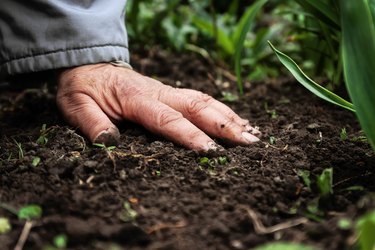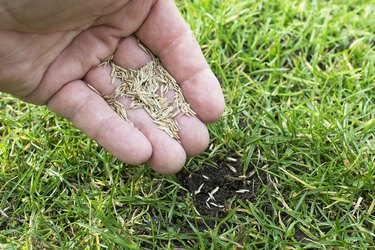
Grass, no matter what species, is carefully selected for the climate and other environmental conditions to ensure a lush lawn by the end of the season. When installing a new lawn, the combination of soil, seed, fertilizer mix and water is essential to successful germination of the grass seed. Whether planting a new lawn or overseeding an existing lawn, using compost or potting soil on the grass also helps keep the seeds moist as they sprout. Grasses thrive in U.S. Department of Agriculture plant hardiness zones 2 through 10, depending on the species.
Types of Grass
Video of the Day
Grass is divided into two basic types: cool and warm season. Cool season grasses thrive in the cool springs and summers of USDA zones 2 through 7. They prefer soil temperatures of 60 to 65 degrees and air temperatures of 60 to 75 degrees Fahrenheit. Cool season grasses go dormant during the hot days of summer.
Warm season grasses grow best in warm climates. They prefer soil temperatures between 70 and 90 degrees and air temperatures from 80 to 95 degrees Fahrenheit. They go dormant when winter's cooler temperatures arrive, generally turning brown after the first frost. The USDA zones range from 6 through 10, depending on the species and cultivar.
Compost, Topsoil or Potting Soil
You might ask yourself what's the difference between potting soil and topsoil? Topsoil is essentially dirt taken from another location. It may be a fairly good, organically-rich loam or a mixture of soils taken from several sites. It will probably contain sticks, rocks and weed seeds.
Compost is a combination of green and brown materials that have been allowed to decompose into an organically-rich soil amendment. Adding compost to soil or raking it over the grass can lighten heavy soils, add organic matter to sandy soils and introduce additional nutrients – all beneficial.
Potting soil is usually a mixture of compost, peat moss, sand or perlite and other elements, including fertilizer. You can mix your own or purchase it in bags ranging from a few quarts to 1 to 2 cubic feet.
New Lawns and Amendments

Prepare the area for the new lawn by removing all vegetation, then tilling in compost, well-decomposed manure, topsoil and amendments as needed. Smooth the soil surface and sprinkle with water. Seed the lawn with your chosen grass species or blend, then roll with a lawn roller to press the seeds into the soil. Scatter a thin layer of sand, topsoil, potting mix or straw mulch over the seeds and keep moist until the grass seeds germinate.
Benefits to Existing Lawns
Existing lawns may benefit from a 1/4-inch-deep layer of topsoil, compost or, in the case of very small lawns, potting soil raked over the grass in spring when the grass is actively growing. When overseeding warm season lawns with cool season grasses to provide a green lawn during the cooler months, covering the seeds and lawn with a thin layer of compost or potting soil helps keep the seeds moist as they germinate. Water regularly until the new seedlings appear, then slowly reduce watering until applying 1 to 2 inches of water weekly.
Cost of Amendments
While soil products, including potting soil, are available in bags of 1- to 2-cubic feet, consider the cost of covering the grass. One cubic foot of compost or potting soil would cover 48 square feet of lawn with 1/4-inch of material. When comparing the costs, also consider your soil type and the size of the lawn. Having a few cubic yards of compost delivered is usually more cost-effective than multiple bags of potting soil.
Potting Soil on Grass

Potting soil is a viable option when patching holes in the grass. Whether caused by insects, drought or playful children and pets, you can fill in those bare spots with a little potting soil and grass seed.
Prepare the spot by loosening the soil. Remove any weeds, rocks and other debris. Fill the hole with enough potting mix to bring it up to the level of the existing lawn. Dig it in, then tamp gently before watering the bare spot.
Press the grass seed into the moist soil mix. Cover with 1/4-inch moist potting soil. Keep moist until the seeds germinate and are actively growing.